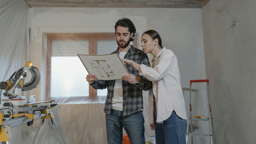| Without question, the details of your house will fall into place in due time. You'll learn—and then have to decide upon—the intricacies of everything from your flooring to the home's many appliances. Each decision will require a little research and a whole lot of common sense. But before you dive into the nuances of trim work or roofing material options, you need to understand the big picture. Before making the first phone call to a log home manufacturer or architect, do your homework. Start by addressing the questions we've listed below, and you'll create a strong knowledge base for building a masterpiece. 1 How do I know what I want?Read log home construction books and magazines. Compile a notebook of ideas, including magazine clippings, that demonstrate the layouts, exterior styles, frame styles, color combinations, furnishings, appliances and finishes that appeal to you. Gather catalogs and plansbooks from log home producers. Surf the Internet for information about log construction techniques. Spend several weekends visiting open houses, and talk to home owners and representatives of log home companies you're considering. Take a hands-on class on log home design and construction, or attend a home show.2 What kind of home do I need?Decide what features are conducive to your family's present and future needs. Are there some rooms in your current home that are essential (e.g., a first-floor master bedroom or a home office)? Or, do you no longer need four bedrooms? Consider a floorplan that supports your family's activities and will help your home remain functional and enjoyable through the years.3 What's my budget?Without a solid understanding of what you can afford, you'll be unable to evaluate designs or compare log home companies and general contractors. A project budget, including other expenses, such as land, septic system and well, allows you to set your priorities and direct your energies toward a realistic plan. Decide which amenities you need immediately and, if there's a budget issue, the items you can postpone until you can afford them. Then figure out how much you can afford to mortgage, what the local and state taxes are and what types of insurance you may have to carry.4 Who will be my mortgage lender?Shortly after you set your budget, find a lender who will pre-qualify you for a home loan. (Some lenders charge a fee for this service; others don't.) Pre-qualification is valuable because it serves two purposes: It lets you know if you'll be approved for a home loan, and it reveals the total amount of money you'll be able to borrow. This information may help to determine if you need to scale back (or if you can add to) your wish list. Ask for lender recommendations from other log home owners, producers and builders to make your experience a smooth one.5 Where will I build?Once you know where you want to build, your options for a log home producer will narrow significantly since many log home builders prefer to build relatively close to their shops. Also, shipping costs become more of an issue when distance is involved. Once you've purchased your land, evaluate its contour. Consider the effect of the seasons, accessibility and views. It's smart to buy your land before you begin designing your home. Knowing what your property's characteristics are will help you make pre-construction decisions like where and how to install your driveway, septic system, plumbing and foundation.6 Have I visited enough model homes?A finished model home will give you a firsthand look at a log home builder's work. Visit both new models and ones that have been standing for several years. An older model will show how the logs have stood over time, and it will show the inherent checking (splitting that happens naturally in dry wood) that will occur in the timbers. Newer models may give you more current design ideas. This also is the perfect opportunity to ask the company's representative questions.7 How will I choose a log home manufacturer?Since each log home manufacturer offers a variety of plans, building services and wood species, know what's available before you talk seriously to any one company. Begin by calling the manufacturers and builders in the region where you're planning to build. Review their literature. Call their client references in your area. Visit their web sites for photos of their homes. Look for a company that you feel is trustworthy and can produce a quality home within your budget.8 Who will design my dream home?If you decide not to go with the log home manufacturer's in-house design staff—or if one isn't available—you may need to hire an independent architect or designer to design your home. Regardless of whether your chosen log home company has a design staff, the company can usually recommend a highly qualified design professional to handle the job. If you venture out on your own and hire an independent architect, be sure that person is familiar with log home construction—and remember to check references. Also, make sure that you introduce your architect to your log home company representative early in the design process. Your log home company representative is a fountain of knowledge and will be able to assist your architect with the fine details of the craft.9 How will I convey my ideas?It's time to pull out your notebook. First, organize your ideas. Think about your property and determine which rooms should face the best views, be given prominence or be tucked away for privacy. Sketch your ideas out on a piece of graph paper and give them to your designer or architect. From your rough sketches, he or she will draw a set of preliminary plans that can be used to estimate how much your home will cost (including materials and labor). At this stage, you'll want to incorporate any design changes, especially if the plans need to be modified to fit your budget. You'll be better off making the changes now rather than during construction when changes can be costly, if not impossible.Once the preliminary plans meet both your budget and expectations, your designer drafts the final construction documents. These are the engineered drawings (also called blueprints) that show your log home manufacturer, lender and general contractor how your log home will be built. 10 Who will build my home?Once the final construction documents are complete, you can make informed decisions about who you'll hire to build and finish your home. If your log home company doesn't provide finishing services as part of your package, then you'll have to hire a builder or general contractor. No matter who builds your home, make sure you have a clear idea of finished costs, how many subcontractors you'll need to hire and how long construction will take. Like any exciting venture, building an architectural wonder requires a little sweat and a great deal of vision. If you read comprehensive articles, contact log home company representatives and visit their web sites, you'll have taken the first crucial steps toward making your dream home a reality. |
How To: Prepare To Build Your Log Home | Tips for Preparing for Home Construction
10 questions to ask before building your dream log home.







_11868_2023-12-20_08-12.jpg)



